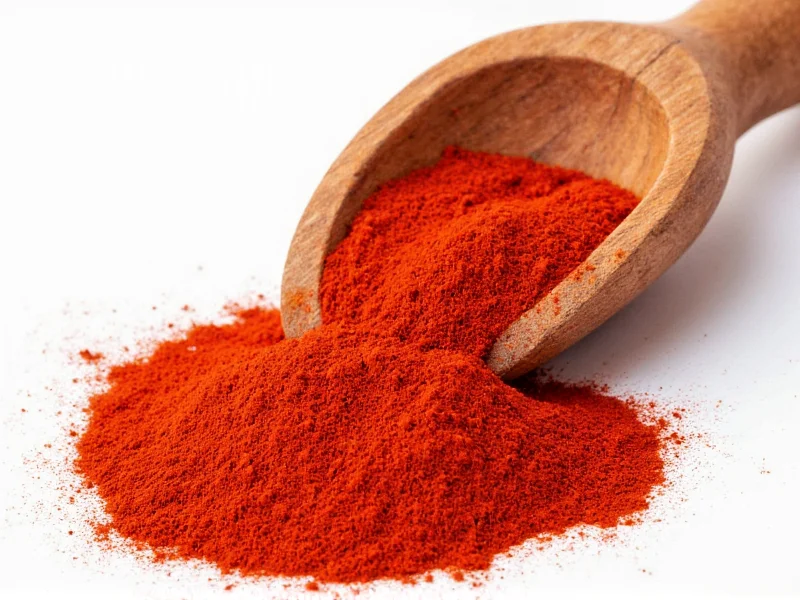When you're in the middle of cooking and realize you've run out of paprika, knowing reliable alternatives can save your recipe. Paprika, made from ground sweet or hot peppers, adds distinctive color and flavor to dishes ranging from Hungarian goulash to Spanish paella. Understanding what makes paprika unique—its vibrant red hue, varying heat levels, and sometimes smoky notes—helps identify the most appropriate substitutes based on your specific culinary needs.
Understanding Paprika Varieties Before Substituting
Paprika isn't a one-size-fits-all spice. Recognizing which type you need to replace is crucial for successful substitution:
- Sweet paprika - Mild flavor, vibrant red color, no heat
- Hot paprika - Contains cayenne or other hot peppers
- Smoked paprika - Made from peppers smoked over oak wood
- Sweet smoked paprika - Combines mild flavor with smokiness
Each variety serves different culinary purposes, so your substitution strategy should match the specific paprika type called for in your recipe. This distinction matters significantly when searching for what is the substitute for paprika in Spanish recipes versus Hungarian dishes.
Top Paprika Substitutes by Category
For Regular Sweet Paprika
When your recipe simply calls for "paprika" without specification, you're likely dealing with sweet paprika. The best alternatives include:
- Chili powder - Use a 1:1 ratio, but note that most chili powders contain additional spices like cumin and garlic powder. This works well for paprika substitute for chili recipes but may alter flavor profiles in more delicate dishes.
- Red bell pepper flakes - Finely crushed dried red bell peppers provide similar color without heat. Use 1.5 times the amount of paprika called for since they're less concentrated.
- Tomato paste + pinch of cayenne - For liquid-based recipes, this combination mimics both color and subtle flavor. Use 1 tablespoon tomato paste plus 1/16 teaspoon cayenne per teaspoon of paprika.
For Smoked Paprika
Replacing the distinctive smoky flavor requires more specialized alternatives:
- Chipotle powder - Provides intense smokiness but is significantly hotter. Use only 1/2 the amount of smoked paprika called for, and consider adding a touch of sweetener to balance heat.
- Liquid smoke + sweet paprika alternative - Combine 1/4 teaspoon liquid smoke with 1 teaspoon of regular paprika substitute per teaspoon of smoked paprika needed. This approach works well for smoked paprika replacement in rubs.
- Smoked sea salt + regular paprika substitute - For dishes where salt content isn't a concern, this combination delivers smokiness without overwhelming heat.
| Substitute | Best For | Ratio | Heat Level | Color Match |
|---|---|---|---|---|
| Chili powder | Chili, stews, meat dishes | 1:1 | Moderate | Good |
| Chipotle powder | Smoked flavor replacement | 1:2 (use half) | High | Fair |
| Red bell pepper flakes | Color without heat | 1.5:1 | None | Excellent |
| Tomato paste + cayenne | Wet recipes, sauces | 1 tbsp + 1/16 tsp per tsp | Adjustable | Good |
| Curry powder | International dishes | 1:1.5 (use less) | Variable | Fair |
Specialized Substitutions for Specific Cuisines
For Spanish Dishes
When making paella or other Spanish recipes requiring smoked paprika (pimentón), consider:
- A blend of sweet paprika substitute plus a tiny amount of liquid smoke (1-2 drops per teaspoon)
- For authentic flavor, seek out Spanish-style smoked paprika alternatives which are milder than standard smoked varieties
- Understanding what is the substitute for paprika in paella specifically requires maintaining the delicate balance of flavors without overwhelming the dish
For Hungarian Cuisine
Traditional Hungarian dishes rely on specific paprika characteristics:
- For goulash, use a combination of sweet red pepper powder and a pinch of cayenne
- Consider adding a small amount of marjoram to mimic the herbal notes in authentic Hungarian paprika
- When exploring paprika substitute for Hungarian goulash, remember that color is nearly as important as flavor in this iconic dish
Common Substitution Mistakes to Avoid
Even with the right substitute, these errors can ruin your dish:
- Ignoring heat levels - Using hot substitutes in recipes calling for sweet paprika
- Over-substituting - Compensating too heavily for perceived flavor differences
- Adding too early - Many substitutes lose flavor when cooked too long; add in the last 5-10 minutes of cooking
- Misjudging color impact - Some substitutes don't provide the same vibrant red hue, affecting presentation
For those with dietary restrictions, understanding paprika substitute without nightshades becomes essential, though options are limited since most alternatives also come from the nightshade family. In these cases, consider using turmeric for color (use sparingly as it has a distinct flavor) or beet powder for color without altering taste significantly.
Creating Your Own Paprika Blend
For the most control over your substitute, create a custom blend:
- Basic sweet paprika substitute: 2 parts dried sweet red pepper flakes, 1 part dried tomato powder, pinch of salt
- Smoked version: Add 1/4 teaspoon liquid smoke per tablespoon of basic blend
- Mild alternative for sensitive palates: Increase the sweet pepper ratio and omit any heat elements
This approach works particularly well when you need a paprika substitute for sensitive palates or when cooking for children. Store your homemade blend in an airtight container away from light for up to 6 months.
When Substitution Isn't Ideal
Some dishes rely so heavily on paprika's unique properties that substitutes may not deliver satisfactory results:
- Traditional Hungarian paprikash
- Authentic Spanish chorizo preparation
- Certain deviled egg recipes where paprika's specific flavor is featured
In these cases, consider adjusting your menu rather than compromising the dish. If you frequently find yourself searching for what can I use instead of paprika, it might be worth keeping a small supply of the most versatile variety (sweet paprika) on hand at all times.











 浙公网安备
33010002000092号
浙公网安备
33010002000092号 浙B2-20120091-4
浙B2-20120091-4